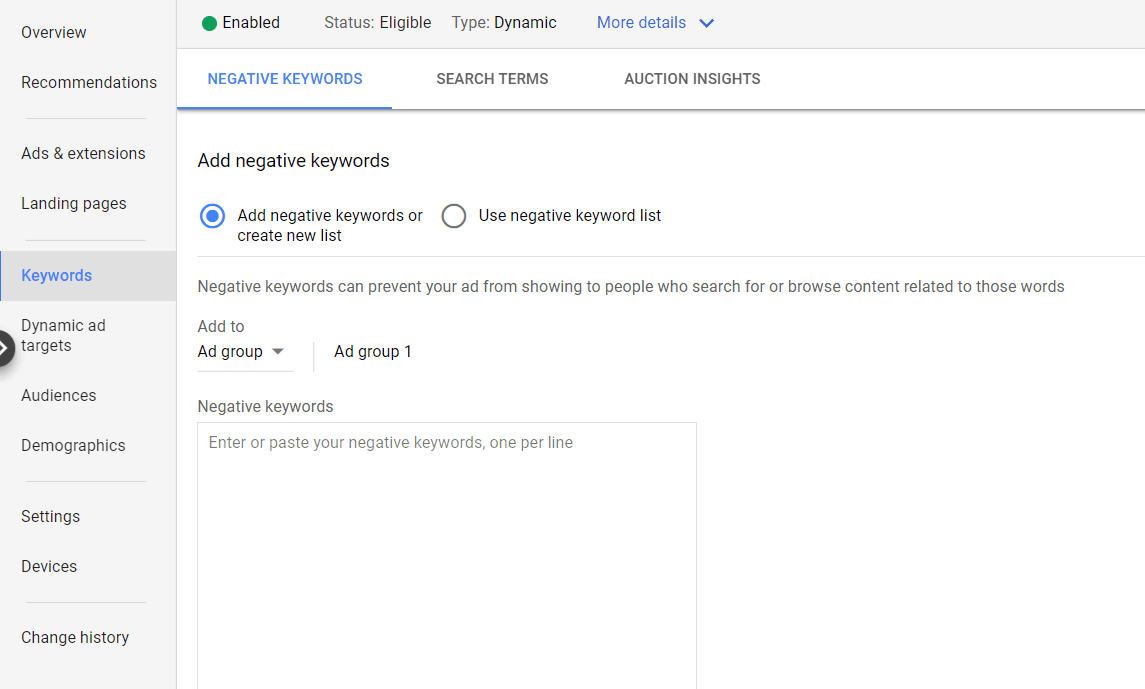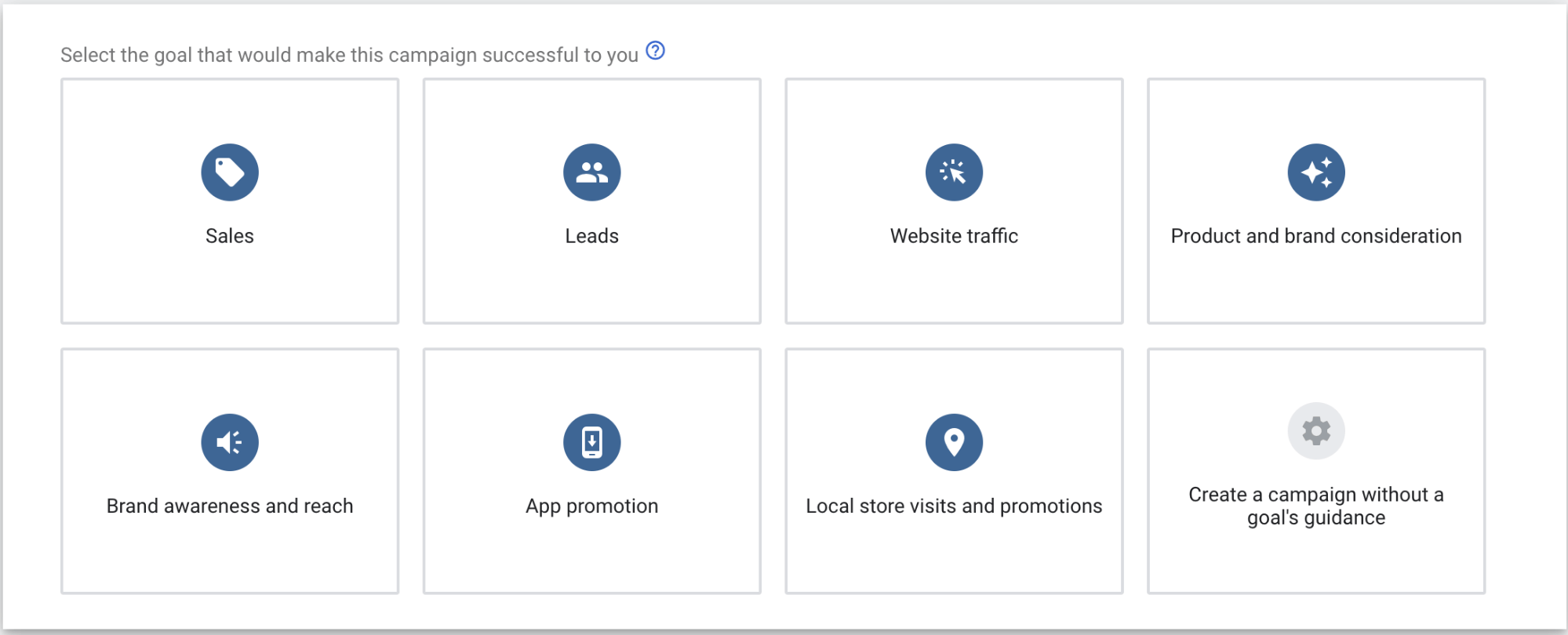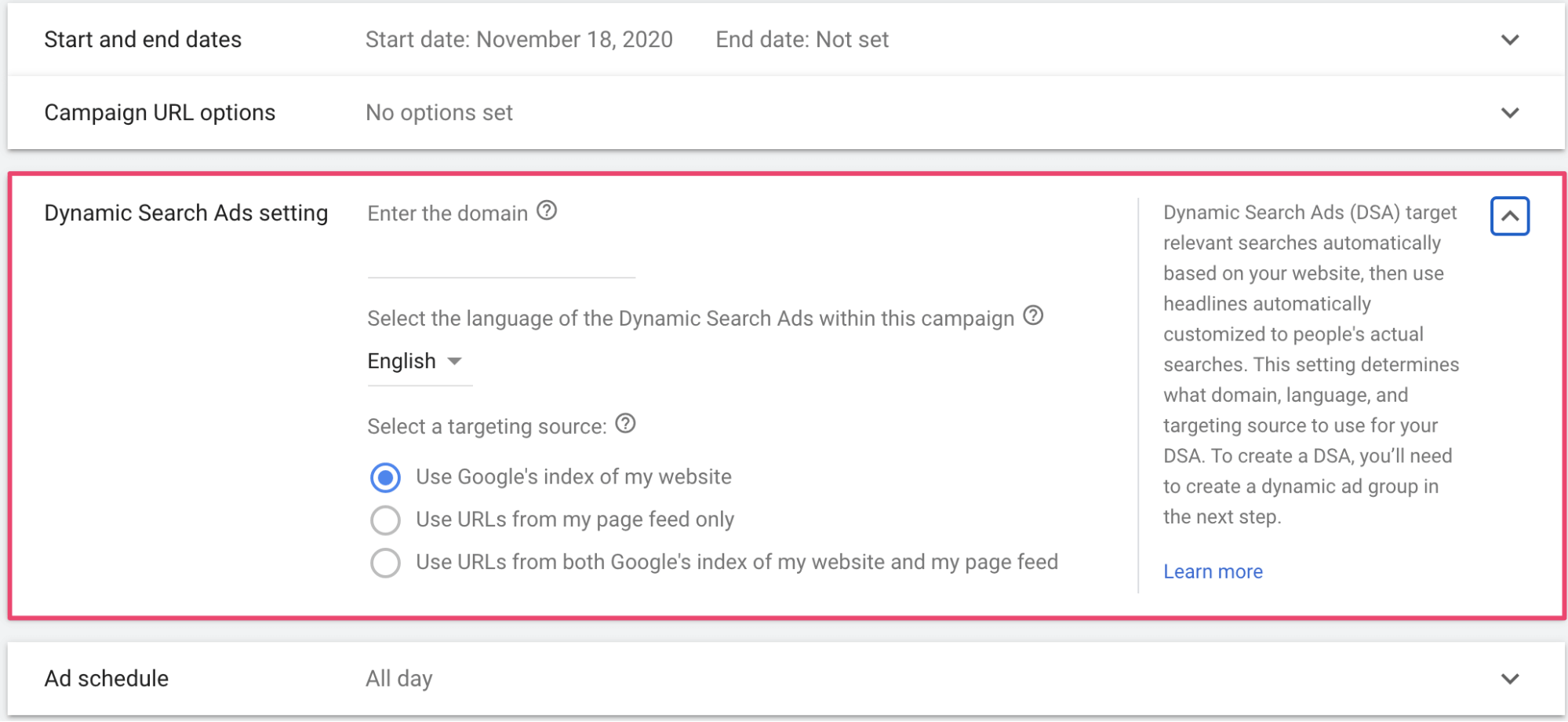If you stop to think about it, how often are people searching for the exact thing you target in your Google PPC campaign?
And what happens to the plethora of unique searches that cross the eyes of the Google gods on a daily basis?
Google has an answer to that: Google Dynamic Search Ads.
Google Dynamic Search Ads are like a good back scratch. They get to all those hard-to-reach places that your search campaign just can’t seem to find.
But there are a few questions we need to answer before we make you an authority on Dynamic Search Ads.
So strap yourselves in, we’re about to go exploring through the DSA jungle.
What are Dynamic Search Ads?
Dynamic Search Ads are advertisements that pop up based on site content as opposed to keywords.
How do they do that? Well, first Google crawls across your site and pulls content.
Once the system has gathered and analyzed your content, it matches all of that data to relevant search terms, automatically generating headlines and landing pages to match.
All of the headlines for these ads are created using dynamic generation from Google.
That means Google is creating a headline for you based on the search that was performed along with information which it pulled from your site.
So, what do you have to do?
Simply write a description line for the ads which can be adjusted at a later time.
This is similar in some ways to text pay-per-click campaigns, where you target keywords and bid on various search items.
But Dynamic Search Ads dropkicks the keywords out of the equation in favor of your site’s actual content.
Someone searching their way through Google would never know the difference between a
Dynamic Search Ad and a text ad.
They appear in the same location and look exactly the same.
Dynamic Search Ads should absolutely be a part of your marketing plan simply because they let you cast a much wider net along Google’s search network while placing dynamic content in front of interested parties.
Aside from that, though, why else should you leverage Dynamic Search Ads?
What are the Benefits of Dynamic Search Ads?
With so many different ad types available, it can be overwhelming.
There’s search ads, display ads, retargeting ads and more. Now there’s Dynamic Search Ads. It can be a challenge to keep up with everything and know when to deploy them.
Once you understand the primary benefit of Dynamic Search Ads, you’ll begin to immediately turn to them in your repertoire of ad campaigns.
The obvious benefit of Dynamic Search Ads is right in the name: they’re dynamic.
They will change and surface the most applicable, personalized result based on the search terms input by the consumer. This makes them more precise and applicable to the consumer making the search.
This personalized ad approach can pay off in the long run. In fact, consumers are 2.1x more likely to view personalized offers than standard ones. Dynamic Search Ads deliver the information that the consumer needs in a way they’d want to consume it.
For example, Luxury Card has responsive ads that appear based on what type of card you’re searching for:
At a time when businesses are constantly seeking to reduce their customer acquisition cost, this added level of a personalization can be just what is needed.
Research shows that personalization can reduce customer acquisition costs by up to 50%.
But that’s not the only benefit of Dynamic Search Ads.
Google Dynamic Search Ads save marketers time and give them a greater control than other forms of Google Ads.
With Dynamic Search Ads, Google will serve ads based on landing page data from your site. You’re able to get hyper-specific with your targeting, and leverage key assets you already own.
In addition, marketers have the ability to customize the URL that appears. Although it sounds like a minor feature, it isn’t offered on many other ad types.
To summarize, Google’s Dynamic Search Ads save marketers time, while increasing their chances for conversions.
How Do You Pay For Dynamic Search Ads?
So, you got all excited from our description of the effective awesomeness that is Google Dynamic Search Ads.
But what’s the catch, right? How do you pay for them?
Well, if you’ve ever run a campaign via Google Ads (formerly known as Google Adwords) you should already be familiar with the process.
Dynamic Search Ads run via a bidding system, very similar to what you’d use when running text ads.
Google’s Dynamic Search Ads operate on a cost-per-click system.
Costs are determined by taking the number of clicks you’ve received and multiplying that by the maximum Cost Per Click limit that you’ve set.
When running a text ad you apply your bids to keywords. Dynamic Search Ads run on an entirely different model, though. Bids have to be applied to the auto-target level.
This is a list of pages on your site which are targeted by Google for Dynamic Search Ads.
Bids are typically set to auto-target, but you can also bid manually.
Choosing the manual bidding option lets you be a little more hands-on with the process (for all of you control freaks out there). This service is available in the advanced options tab under the additional settings section.
Smart Bidding is also available. No, the other forms of bidding aren’t dumb.
Smart bidding is just a variation of automated bidding which uses machine learning to optimize for conversions throughout every auction.
This improves backend performance while using four key benefits that Google claims will help you improve your overall campaign performance.
And it saves you time in the process.
The four key benefits are:
- Advanced Machine Learning
- Contextual Signals
- Flexible Performance Controls
- Transparent Performance Reporting
These machine learning algorithms help you predict how different bid amounts could increase the likelihood of a conversion.
This is much more effective than manual bidding undertaken by an individual or team.
Depending on what you’re looking to accomplish, it’s a good idea to set up a number of different bidding philosophies.
For example, the Target Cost Per Acquisition philosophy is undertaken to improve your overall cost per acquisition by automatically optimizing bids and tailoring them for each auction.
And Target Return on Ad Spend (ROAS) allows you to place bids that are optimized to hit a targeted return on investment. This is available as a standard strategy which can work for a single campaign or a portfolio strategy that runs along multiple campaigns.
What Is Your Targeting Criteria for Dynamic Search Ads?
In order to control your costs, you need laser-sharp copy and accurate targeting.
Both are essential. If your copy is weak and your targeting is spot-on, you won’t convert. On the opposite end of the spectrum, if your targeting is off and your copy is great, the right consumers won’t see your ad.
With Dynamic Search Ads, you can use existing web pages to target certain sets of keywords that your audience will be actively seeking. Web page data from across your site will inform which advertisement Google serves to the end user.
That is why Dynamic Search Ads are so special. Google displays an ad that is customized to what the person is searching.
Ad personalization is essential. You should always be striving to get more specific with your ad targeting and messaging. The relevance of your ad will be critical in your quest to drive more clicks for your brand.
More than 91% of consumers are more likely to purchase from brands that provide offers and advertisements that are relevant to them.
But how exactly can you target your customers with Dynamic Search Ads?
For starters, you can pull keywords from your web page data by inserting your URL.
Page data is commonly the foundation for Google Dynamic Search Ad campaigns. Google offers the following three targeting buckets:
- Categories
- URLS
- Other factors such as page title or page content
With any of these factors, you can set up a relevant DSA ad group.
This DSA ad group will help you ignore irrelevant traffic that traditional campaigns sometimes draw in as a result of Google’s algorithm. Let’s look at how each works individually.
For categories, you can set up certain criteria for your targeting. For example, you might target only your landing pages from your standard ad groups that you use across all your marketing campaigns. This would serve Dynamic Search Ads for queries that include search terms relevant for those pages.
Perhaps you’d want to target specific URLS. Google Dynamic Search Ads’ URL targeting enables you to go broad or narrow depending on your preference. You can target broad matches with the “URL_Contains” function or exact matches with the “URL_Equals” function.
No matter which targeting mechanism you choose, Dynamic Search Ads will be a weapon in your marketing toolkit to convert more customers and increase sales.
How Have Dynamic Search Ads Changed?
Dynamic Search Ads have been around for a while, first hitting the scene in 2011.
Then, like an aging child actor, it reinvented itself as the years went on.
Dynamic Search Ads changed their process quite a bit back in 2015. Whereas once this service used to just crawl the site and index information, it has since evolved to include increased organization.
Now, Google’s bots categorize all the pages of your website based on what services and products you provide.
This helps the system target ads more effectively while giving the user more control than the old model. It also allows for increased transparency throughout the entire process.
Users can control how their ads show and select which pages the searches will lead to. And Google allows them to see example queries that might trigger the ad.
Another feature that was added in later was the ability to see recommended bids, which were included to help marketers budget their campaigns more effectively.
Recommendations for these bids are based on the performance of existing keywords under similar queries.
Should I use Dynamic Search Ads?
Every company’s marketing strategy will be different. However, there are a few reasons why Dynamic Search Ads may be the right fit for your marketing plan.
As we’ve mentioned before, they’re simple to set up.
It takes way less work than text or display ads. Dynamic Search Ads campaigns can be up and generating clicks within a day.
If you have dozens of pages on your website or hundreds of products, Dynamic Search Ads will be a great fit for you. Specifically, the dynamic generation of headlines will come in handy, saving your digital marketing manager time from manually generating each headline.
Manual campaigns can be challenging for even the most skilled ad strategist to manage.
There’s keyword lists, query errors, varying ad copy and almost a new targeting option popping up each day. (At least, that’s what it feels like.) That’s why a Dynamic Search campaign should be a consideration for almost all businesses.
The generated headlines are always based on the matched product, so they are always relevant to the search at hand.
And when it comes to creating ads, the headline is by far the most important aspect. Even more important than the page description.
That’s because headlines grab attention. Those paper boys in old movies weren’t yelling out an article’s lead to get people to buy the newspaper. They were shouting the headlines.
Different time period, same concept.
Without a good headline, no one will ever notice the description you’ve painstakingly written.
And luckily, Dynamic Search Ads take care of that for you.
Another added benefit of Dynamic Search Ads is that they can show up for keywords with a low search volume. This helps you catch some of those searches that aren’t being targeted by text campaigns.
What’s the Catch with Dynamic Search Ads?
Unfortunately, Dynamic Search Ads are not a perfect system yet and there are a few cons nestled in there among the good.
For one thing, the dynamic headlines and the ad copy don’t always match up. It all depends on what the search was for and how it pertains to your page.
DSA can also be quite difficult for someone who wants total control over their brand’s messaging.
Since the dynamic headlines are based on site content, you’re placing a lot of trust in Google and hoping that its automated system won’t let you down.
Giving up control can be daunting for some marketers. Having absolutely no choice over what kind of queries you’re matched with could be enough to drive some away from Google Dynamic Ads entirely.
But there is a way to wrestle some power back from Google.
One way to do so is to use a list of negative keywords.
When picking what negative keywords to include, try to imagine how Google could mess up the classification of your products. List a number of keywords that are associated with these predicted mistakes and include them in your list.
Negative keywords help preserve marketing dollars by not throwing away ad spend on irrelevant searches.
Finally, don’t forget to monitor your campaign. You can’t just set and forget it.
Your campaign will need close monitoring for the first few days so make sure you’re constantly reviewing search term reports to ensure that everything is optimal.
Remember, it’s easy for your budget to be needlessly eaten up if there is no structural optimization and negative keywords have not been selected.
How to Create a Google Dynamic Search Ads campaign?
So you’re ready to start working on your Dynamic Search Ads, but now you don’t know where to start.
If you’ve ever run a text campaign, you’ll find that the opening steps are very similar. Simply start off as though you’re creating a text campaign.
Sign in to your Google Ads account. Click on the tab marked “Campaigns.”
Click the blue “+” sign on the left-hand side of the page and select “New Campaign.”
Then you’ll have to select what kind of ad you want to run and what your goals are. There are a number of options.
Once you select your ad goal, select “Search” for your campaign type and click continue.
This will open up the campaign settings page.
There you’ll see a small blue link marked “Show More Settings.” Click on it to open up a drop-down menu.
The third option down will be Dynamic Search Ads.
Click on that to expand the menu and click on the box that says “Enable Dynamic Search Ads.”
Enter your website domain, select your language, and select your targeting source from the three options listed.
After this, you can expand the location options to target specific geographic regions and select a bid strategy.
Once that’s done, enter your default bid and click “Save and Continue.”
After all that, you’re ready to start creating ad groups.
If you want to target via categories, select “Target categories recommended for your website,” and select the categories that are relevant to you. Add them all into the Dynamic Ad Targets tab column.
Finally, you’ll be able to create the actual dynamic advert by writing out up to 90 characters in the creative description line.
Once you’ve done this, your campaign is created!
Reel Dynamic Search Ads in With Dynamic Remarketing
Remarketing is one of the most effective ways to reel in prospects who have already visited your site or taken some kind of pre-determined action while there, like requesting additional information or clicking on a specific product.
Through the tracking of cookie data, Google can put your ads in front of them and remind them that you exist. You can even urge them back with a discount or special.
You can also do this with Dynamic Search Ads.
While remarketing does limit the campaign’s reach to people who have already seen you, it lets Google find more qualified prospects.
If they’ve been to your site previously, they are likely people who are searching for services like the ones that you offer.
You can also layer remarketing audiences throughout your Dynamic Search Ad campaign.
And once done, you can increase your bids on remarketing targets while still bringing in new customers.
When setting your bids, there are two different options to choose from.
The “Bid Only” option targets everyone. Adjustments can be made later for certain segments of the audience, such as remarketing targets.
This option adds lists and categories that you can set bids on. One of its best features is that it will still show your ads when any of the other targeting methods match up.
The “Target and Bid Only” option targets users that are associated with the lists and categories you’ve chosen and then gives you the option to bid on them.
Conclusion
Dynamic Search Ads are a great way to supplement your existing text ad search, as long as they’re done correctly.
It gives you the option to leverage your page content to effectively catch searches that are not covered by your text ads.
If optimized properly you could stand to make a pretty penny and increase your brand awareness with Google Dynamic Search Ads.
So, what are you waiting for? Log in to your Google Ads account and let the magic of Dynamic Search Ads work in your favor!













thanks for good article
You’re doing great work. Keep it up
You’re doing great work. Keep it up
I too started to use dynamic search ads for my campaigns. this blog post is informative. Thanks
thanks. i like your article, succes always
Nice to see your post. The wonderful and deep post you’ve written here. That’s truly has added a lot to our knowledge about this topic.